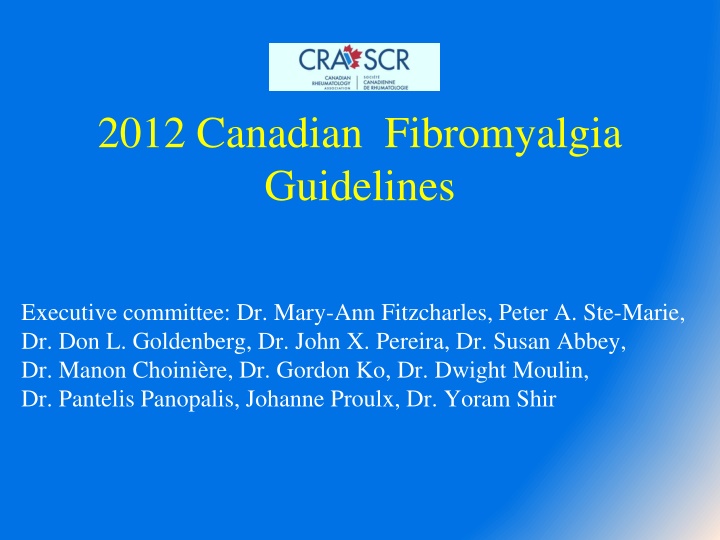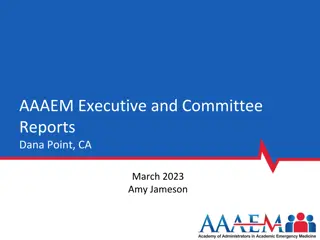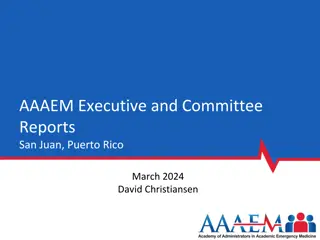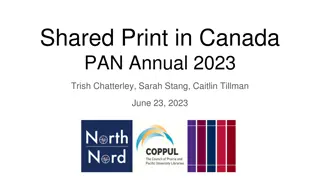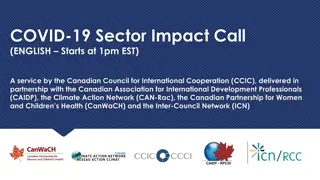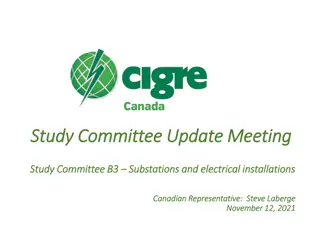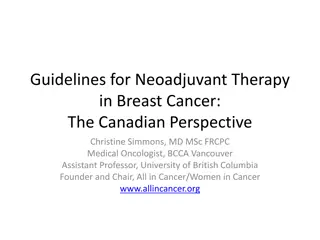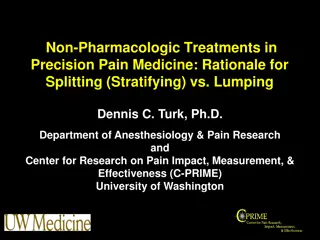2012 Canadian Fibromyalgia Guidelines - Executive Committee & Objectives
Providing clinically applicable guidelines for Canadian healthcare professionals in the diagnosis and management of fibromyalgia, the 2012 Canadian Fibromyalgia Guidelines were developed by an expert committee with a comprehensive methodology, supported by financial transparency and conflict of interest disclosures. The guidelines aimed to address the need for updated guidance due to advances in understanding the condition, new diagnostic criteria, and evolving treatment approaches.
Uploaded on Feb 19, 2025 | 4 Views
Download Presentation

Please find below an Image/Link to download the presentation.
The content on the website is provided AS IS for your information and personal use only. It may not be sold, licensed, or shared on other websites without obtaining consent from the author.If you encounter any issues during the download, it is possible that the publisher has removed the file from their server.
You are allowed to download the files provided on this website for personal or commercial use, subject to the condition that they are used lawfully. All files are the property of their respective owners.
The content on the website is provided AS IS for your information and personal use only. It may not be sold, licensed, or shared on other websites without obtaining consent from the author.
E N D
Presentation Transcript
2012 Canadian Fibromyalgia Guidelines Executive committee: Dr. Mary-Ann Fitzcharles, Peter A. Ste-Marie, Dr. Don L. Goldenberg, Dr. John X. Pereira, Dr. Susan Abbey, Dr. Manon Choini re, Dr. Gordon Ko, Dr. Dwight Moulin, Dr. Pantelis Panopalis, Johanne Proulx, Dr. Yoram Shir
Why develop Guidelines? Recent guidelines 10 years old Advances in understanding FM Neurophysiologic Treatments New diagnostic criteria (ACR 2010) Call for guidance & direction Requested by Canadian Pain Society
Objectives To provide Canadian healthcare professionals clinically applicable guidelines for use in daily practice Diagnosis Management Patient trajectory
Makeup of guideline group Executive committee: 11 persons Health care professionals, international expert, project coordinator, patient representative National Fibromyalgia Guideline Advisory Panel (NFGAP) 139 healthcare professionals invited 35 agreed to participate and completed voting process All healthcare professionals active in the care of FM and chronic pain patients.
Methods Step 1: Needs assessment Step 2: Literature search Step 3: Grading of evidence Step 4: Writing Step 5: Advisory Panel votes on recommendations Step 6: External Revision Step 7: Publication & Dissemination
Financial support & conflicts of interest Guideline development requested by CPS Louise and Alan Edwards Foundation Research assistant: salary support All participants stated conflicts of interest Needs assessment Unrestricted educational grant by Valeant without any input to content No additional industry support
The literature search 18 key questions McGill Librarians did formal lit search Embase, MEDLINE, PsychInfo, Pubmed, Cochrane, grey literature, hand search >5000 articles Titles, abstracts reviewed, duplicates removed 360 retained
How we did the job 18 questions & 360 articles Each article read graded (JADAD) level of evidence (Oxford) Literature is summarized in three sections Recommendations are formulated by the Executive committee, assigned a level of evidence and a grade.
Methods: Assessing individual studies Grading of individual articles was by JADAD method (out of 5): Was the study described as randomized? Was the study described as double blind? Was there a description of withdrawals and dropouts? The method of randomization was described in the paper, and that method was appropriate. The method of blinding was described, and it was appropriate. Points deducted if: The method of randomization was described, but was inappropriate. The method of blinding was described, but was inappropriate.
Assigning a level of evidence for each recommendation Overview of the Oxford Centre for Evidence Based Medicine (level of evidence table) Level 1 Systematic review of RCTs Level 2 RCT (or observational studies with dramatic effect) Level 3 Non-RCT cohort/follow-up study Level 4 case-control studies, historically controlled studies Level 5 Opinion
Grading of recommendations A consistent level 1 studies B consistent level 2 or 3 studies or extrapolations from level 1 studies C level 4 studies or extrapolations from level 2 or 3 studies D level 5 evidence or troublingly inconsistent or inconclusive studies of any level * Level may be graded down or up by experts
46 recommendations formulated NFGAP voting process: SurveyMonkey used Advisors had access to full document Voted in three sections: Recommendation Grading of recommendation 80% required for acceptance
Guidelines address three broad concepts Diagnosis and evaluation Management Patient trajectory and follow-up 12 23 11 new clinical concepts regarding FM have been incorporated into these guidelines.
Where we currently stand 44 page document (12 000 words) 336 references Endorsed by Canadian Pain Society and Canadian Rheumatology Association. Publication & dissemination in progress
The diagnosis Composite of symptoms (level 5) 2/3 pain 1/3 other (Sleep disturbance, fatigue, cognitive dysfunction..) Diagnosis (level 5) Clinical construct Simple blood tests only Physical exam must be done (level 5) Exclude other conditions Tender points not required
Diagnosis (cont.) As early as possible (level 5) Primary care is ideal setting (level 1) Access to team member for support (level 3) Specialist referral only if (level 5) Atypical symptoms Difficulties in management eg. sleep specialist, psychologist
Diagnosis (cont.) Healthcare professionals need education (level 5) Empathetic, shared decision-making (level 3) Contributing factors such as genetics or triggering events must not hinder care(level 5) ACR 2010 criteria (level 3) May validate clinical diagnosis
Management (overview) No ideal treatment Patient tailored approach (level 5) Symptom-based management Non-pharmacologic & pharmacologic strategies Aim to symptoms Maintain / improve function
Management (overview cont.) Self-management strategies are imperative (level 1) Patient active participant!! (level 1) Multimodal approach (level 1) Realistic goals (level 5) Pacing, but continue normal life (level 4)
Management (psychological interventions) Internal locus of control Recognize psychological distress (level 3) Patient education better coping skills (level 5) Improve self-efficacy (level 1) Psych counselling helpful for some (level 5) CBT (level 1)
Management (non-pharmacologic) Exercise (level 1) Best available evidence Any type aerobics, water based, stretching, etc. CAM Insufficient evidence (level 1) Encourage disclosure of use (level 5)
Management (pharmacologic) No perfect drug Lowest dose, gradual increase (level 5) Expect only a modest response Consider combination drugs (level 5) Be knowledgeable regarding drug mechanisms (level 5) Constant evaluation re risk vs. benefit (level 5)
Management (pharmacologic cont.) WHO step-up analgesic ladder (level 5) NSAIDS low dose, short use (level 5) Tramadol moderate/severe pain (level 2) Strong opioids discouraged (level 5) Cannabinoid (pharma) sleep (level 3)
Management (pharmacologic cont.) Antidepressants Explain mechanism to patient (level 5) TCAs, SSRIs & SNRIs can be used (level 1) Choice MD knowledge, Pt characteristics (level 5) Anticonvulsants Explain mechanism to patient (level 5) Low dose (level 1)
Patient trajectory Follow-up time interval depends on MD judgment (level 5) New symptoms Evaluate using clinical judgment (level 5) FM symptoms persist, wax and wane (level 3) No value to dwell on past lifetime events, move forward (level 5)
Patient trajectory (continued) Poor outcome when (level 5) Passive patient External locus of control Untreated prominent mood disorder Outcome tools Patient Global Impression of Change (level 3) Goal attainment (level 5) Do not use tender points for outcome (level 3)
Patient trajectory (work & costs) Retention in workforce encouraged (level 3) Rehab program if necessary (level 5) Reduce costs by treating depression (level 3)
Key points Clinical construct Primary setting is recommended Do not over medicalize patient Non-pharma strategies VIP Patient ownership Symptom-based management No ideal drug Drugs show modest effects only Encourage retention in workforce
Thank you!! Any questions?
